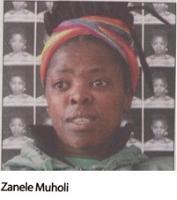
THE TASK of a writer engaging with the work of artists and activists is important. The critic not only draws attention to the work of particular people but provides a way for readers and viewers to translate and understand the works they view.
What is written about the work of visual activist Zanele Muholi, for instance, can help us think about questions of race, sexuality, violence and intimacy after apartheid. On the other hand, a writer responding to her images can compound problematic ways of seeing and thinking and can, even if unwittingly, reinforce homophobic views.
This is unfortunately the case in art critic Mary Corrigall's review of Muholi's latest exhibitions in Joburg published in the Sunday Independent.
In a tone stranaelv reminiscent of a conservative US right-winger, Corrigall argues that the art world has provided Muholi with a place for"her"community because the art world "has always been a gay-friendly if not gay-dominated one"In this way the review elides the fact that black women artists, let alone black lesbian artists, number few in our context. It fails to consider the psychic toll and physical risks involved in being South Africa's most visible queer activist in a context of extreme homophobia and violence.
Corrigall questions whether Muholi's activism extends beyond the art world. This betrays her ignorance of the organisation Muholi founded, Inkanyiso, as well as what Muholi's work has meant for queer activists here and abroad.
The review focuses on Of Love and Loss,a series of photographs that record and celebrate queer weddings and document the funerals of lesbians who have been raped and killed.
These two kinds of ceremonies are important social rituals for queer communities and are private spaces of joy and grief as well as political spaces that show how far we have come and how far we have to go before there is justice for all.
Corrigall mentions Muholi's current show with Gabrielle le Roux at the Wits Art Museum, Queerand Trans Art-iculations: collaborative art for social change. Corrigall argues that the uniformity of Muholi's treatment of those she photographs in her Faces and Phases series reduces the space for expression of individuality.Corrigall insists Muholi's desire is to "normalise" homosexuality.
Homosexuality is not abnormal and therefore does not require normalisation.
What Muholi's work aims to do is refuse the bounds of the so-called normal, by exploding such limits.
There is a growing body of scholarly writing about Muholi's work by academics like Desiree Lewis, Pumla Gqola, Zethu Matebeni and myself, and by people like Andrew van der Vlies, Brenna Munro and Henriette Gunkel in the UK, US and Europe. Corrigall would have done well to have read some of this work or spoken to some of the writers.
Corrigall's piece displays an astonishing lack of consciousness about the politics of race and representation as well as of the intersections between compulsory heterosexuality and sexual violence as experienced by women,queeridentified or not, and by men who do not perform heterosexist normativity.
She critiques Muholi for not documenting the lives of white lesbian women.
She goes on to write:"Similarly,what of all the heterosexual women in this country who are raped and murdered because they don't conform to conventional or traditional ideas about women imposed on them? Or is this too everyday a subject? Who Muholi photographs doesn't only determine who turns up on opening night, but exposes who is in, or out."
Violence visited upon heterosexual women is bound to the violence queer people experience.
What are the connections between the murder of Anene Booysen who was raped and disembowelled in the Western Cape last year and the murder of Duduzile Zozo who was raped and killed, her body found with a toilet brush inserted into her vagina in Gauteng last year?
Was Anene straight or queer?
Was Duduzile a mother? Why does this matter?
Certain people are marked for death as a result of their choices about who to love; what they wear, how they choose to think and whether and with whom they choose to have children.
Should all acts of rape be understood as hate crimes?
Are white women subject to the same kinds of violence as that experienced by black women?
These are important questions that Muholi's work opens up and that the series of rhetorical questions that Corrigall's review poses but makes no attempt to answer.
Corrigall implies Muholi's work has aestheticised lesbian rape and has made of homophobic violence a kind of fashionable topic.
Corrigall fails to grasp the political force of Muholi's work and overlooks the artist's position.
When the then Minister of Arts and Culture Lulu Xingwana walked out of the Innovative Women exhibition in 2009 she left because she claimed the photographs on display were"immoral, offensive" and "went against nationbuilding" This kind of statement from those who hold power is what,to quote Corrigall,"exposes who is in, or out".
By Kylie Thomas
Source: Sunday Independent
Thomas is a senior lecturer in the Department of Fine Art at Rhodes University.
